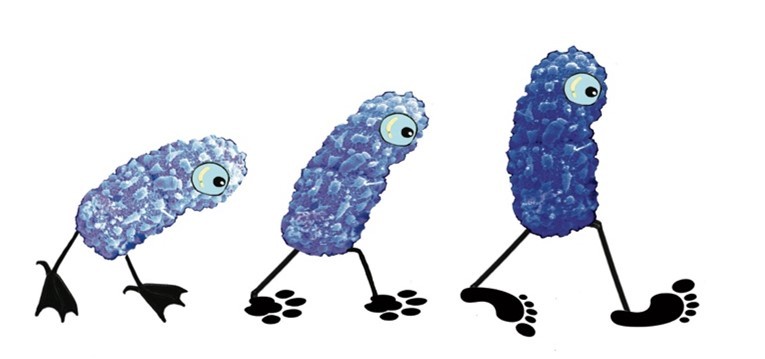Droevendaalsesteeg 4, Wageningen, Gelderland, The Netherlands
25 Rue du Docteur Roux, Paris 15e Arrondissement, Île-de-France, France
Galway, Connacht, Ireland
Pescara, Abruzzo, Italy
Anker Engelunds Vej 1, Stampen, Region Hovedstaden, Denmark
Artillerivej 5, Copenhagen, Region Hovedstaden, Denmark
Vienna, Wien, Austria
14 Rue Pierre et Marie Curie, Maisons-Alfort, Île-de-France, France
147 Rue de l'Université, Paris 7e Arrondissement, Île-de-France, France

The Project #METVETKLEBS
| Start: | 1 January 2018 |
| Duration: | 2 Years |
| Domain: | Foodborne Zoonoses |
| Keywords: | K. pneumoniae; Harmonization of detection and isolation, environmental niches, population biology, transmission modelling |
| Contact: | Sylvain Brisse (IP) |
MedVetKlebs: Klebsiella pneumoniae from ecology to source attribution and transmission control.
MedVetKlebs was a multidisciplinary international project that achieved the aim to define the ecology of Klebsiella pneumoniae (Kp) and the sources of infections of humans and animals in order to investigate transmission routes and to find an optimal way to control them.
Klebsiella, and in particular K. pneumoniae (Kp), is a major contributor to the global burden of infectious diseases in humans. It represents nearly 10% of nosocomial infections in the Western world, and is among the top six human pathogens responsible for approximately 1.27 million deaths in 2019 attributable to antimicrobial resistance (AMR), as referenced here. Kp is considered by different public health agencies (WHO, ECDC, CDC) as a ‘critical bacterial pathogen’ given the emergence of highly multidrug resistant (MDR) strains with increasing resistance to carbapenems and other ‘last resort’ antimicrobial agents (colistin, tigecycline). The European Parliament report on Antimicrobial Resistance (IP/A/STOA/SC/2005-173) stated: “The increasing development of such pan-resistant organisms has the potential to become a worldwide catastrophe.”
Additionally, Kp is also a model of ubiquitous bacteria that should be analysed in a One Health perspective, given its broad ecological distribution in animals (including humans) and environment, and its capacity to contaminate food. However, despite the recent renewal of interest in Kp epidemiology, there is a lack of standards on the detection and isolation of Kp strains in environmental, food, animal or other samples. The MedVetKlebs project aimed to enhance Kp research and surveillance by developing and harmonising study methods and by investigating its ecology and transmission across sources.
In this context, the main aims of MedVetKlebs were to:
- Develop and harmonize methods of detection, isolation and quantification of Kp.
- Ensuring a broad sampling of ecological niches and deep sampling of potential sources.
- Performing genomics analysis and transmission modelling, including development of new methods for source attribution and risk assessment.
- Inform the scientific community and decision-makers in order to optimize current practices.
As a consortium, we consider that the MedVetKlebs project was highly successful in achieving its scientific tasks, fostering novel collaborations among partner institutions, providing novel analytical methods and understanding of Kp diversity, ecology and epidemiology, and integrating and harmonizing Klebsiella study methods among partners and beyond.
Of note, in addition to initially planned tasks, the MedVetKlebs consortium has achieved supplementary tasks, such as a MALDI-TOF identification of Klebsiella and the development of a web-based tool, and the taxonomic update of the Klebsiella genus (description of four novel Klebsiella species or subspecies).
Project Outcomes
First, our methodological developments and validations (culture and isolation methods, molecular detection, MALDI-TOF identification, taxonomic descriptions) will improve laboratory work, and thereby impact positively laboratory capacity in the detection, identification, surveillance, epidemiology and ecology of Klebsiella. Our novel methods and tools (e.g., ZKIR qPCR or Klebsiella MALDI-TypeR) have already been adopted by research consortia on Klebsiella and may be adopted by microbiology laboratories, including reference laboratories, in their workflows.
Second, the data on the prevalence and resistance/virulence of Klebsiella in varied sources, generated by the MedVetKlebs project, will contribute to better assess the risk associated with potential sources or reservoirs of Klebsiella.
Third, our modelling approach to define outbreak genetic distance thresholds (in press) may provide a very useful tool to define outbreaks of Kp and other food-borne or environmental pathogens.
Fourth, the genomic data generated in this study, integrated into the Klebsiella genomic library and nomenclature server BIGSdb-Pasteur, will contribute to define Klebsiella subtypes and track their spread more efficiently.
Additionally, we have also collaborated with other international projects (SpARK, KLEB-GAP, NOR-KLEB-NET) providing expertise, culture and qPCR protocols developed in the MedVetKlebs project (ahead of public dissemination) and we have constructed an international network of scientists involved in Klebsiella research and capacity building in genomics (Kleb-NET, Kleb-NET GSP), which was built upon initial networking activities within the MedVetKlebs project.
Read a blog post about MedVetKlebs research news.
Science to Policy Impacts
We have approached different stakeholders (EFSA and ECDC) in order to inform them of the outputs reached during this project, and more precisely, we have agreed on collaborating on genomic nomenclature of strains for pan-European tracking purposes.
Project Outputs
- Barbier, E., Rodrigues, C., Depret, G., et al. (2020). The ZKIR Assay, a Real-Time PCR Method for the Detection of Klebsiella pneumoniae and Closely Related Species in Environmental Samples. Applied and Environmental Microbiology. 86(7), e02711-19. DOI: https://doi.org/10.1128/AEM.02711-19
The development of ZKIR qPCR, a highly sensitive real time PCR method which detects Kp and its closely related species from soil, food, faeces and other complex matrices, hugely improved the laboratory work, and thereby impacted positively laboratory capacity in detection, identification, surveillance, epidemiology and ecology of Klebsiella, as it is also reflected in the second output (multicentric study). Furthermore, ZKIR qPCR has been validated and improved by other consortia not only as a detection method but also as a quantification method of Kp in human faecal samples. This technique may be adopted by microbiology laboratories, including reference laboratories, in their workflows.
- Rodrigues, C., Hauser, K., Cahill, N., Ligowska-Marzęta, M., Centorotola, G., Cornacchia, A., Garcia Fierro, R., Haenni, M., Nielsen, E. M., Piveteau, P., Barbier, E., Morris, D., Pomilio, F., & Brisse, S. (2022). High Prevalence of Klebsiella pneumoniae in European Food Products: a Multicentric Study Comparing Culture and Molecular Detection Methods. Microbiology Spectrum. 10(1), e0237621. DOI: https://doi.org/10.1128/spectrum.02376-21
Our multicentric study provided and implemented a novel isolation strategy for KpSC from food matrices and showed that KpSC members are highly prevalent in salads and chicken meat, reinforcing the view of food as a potential source of KpSC colonization in humans. Despite the large genetic diversity and the low levels of antimicrobial resistance detected, the occurrence of identical genotypes across samples suggests high rates of transmission of KpSC within the food sector, which need to be further explored to define possible control strategies.
- Duval, A., Opatowski, L., & Brisse, S. (2023). Defining genomic epidemiology thresholds for common-source bacterial outbreaks: a modelling study. The Lancet Microbe. 4(5), E349-E357. DOI: https://doi.org/10.1016/S2666-5247(22)00380-9
We propose an evolutionary approach to the ‘single strain’ conundrum by defining the most appropriate genetic threshold based on individual outbreak properties. This forward model, broadly applicable to foodborne or environmental-source common source case clusters or outbreaks, will be useful for epidemiological surveillance and to guide control measures.
Project Assets
Duval, A., Opatowski, L., & Brisse, S. (2023). Defining genomic epidemiology thresholds for common-source bacterial outbreaks: a modelling study. The Lancet Microbe. 4(5), E349-E357. DOI: https://doi.org/10.1016/S2666-5247(22)00380-9
Hooban, B., Fitzhenry, K., O’Connor, L., Miliotis, G., Joyce, A., Chueiri, A., Farrell, M. L., DeLappe, N., Tuohy, A., Cormican, M., & Morris, D. (2022). A Longitudinal Survey of Antibiotic-Resistant Enterobacterales in the Irish Environment, 2019-2020. Science of the Total Environment,. 828, 154488. Advance online publication. DOI: https://doi.org/10.1016/j.scitotenv.2022.154488
Rodrigues, C., Desai, S., Passet, V., Gajjar, D., & Brisse, S. (2022). Genomic evolution of the globally disseminated multidrug-resistant Klebsiella pneumoniae clonal group 147. Microbial Genomics. 8(1), 000737. DOI: https://doi.org/10.1099/mgen.0.000737
Rodrigues, C., Hauser, K., Cahill, N., Ligowska-Marzęta, M., Centorotola, G., Cornacchia, A., Garcia Fierro, R., Haenni, M., Nielsen, E. M., Piveteau, P., Barbier, E., Morris, D., Pomilio, F., & Brisse, S. (2022). High Prevalence of Klebsiella pneumoniae in European Food Products: a Multicentric Study Comparing Culture and Molecular Detection Methods. Microbiology Spectrum. 10(1), e0237621. DOI: https://doi.org/10.1128/spectrum.02376-21
Chiarelli, A., Cabanel, N., Rosinski-Chupin, I., Zongo, P. D., Naas. T., Bonnin, R. A., Glaser, P. (2020). Diversity of mucoid to non-mucoid switch among carbapenemase-producing Klebsiella pneumoniae. BMC Microbiology. 20, 325. DOI: https://doi.org/10.1186/s12866-020-02007-y
Jousset, A. B., Bonnin, R. A., Takissian, J., Girlich, D., Mihaila, L., Cabanel, N., Dortet, L., Glaser, P., & Naas, T. (2020). Concomitant carriage of KPC-producing and non-KPC-producing Klebsiella pneumoniae ST512 within a single patient. The Journal of Antimicrobial Chemotherapy. 75(8), 2087–2092. DOI: https://doi.org/10.1093/jac/dkaa137
Barbier, E., Rodrigues, C., Depret, G., Passet, V., Gal, L., Piveteau, P., Brisse, S. (2020). The ZKIR Assay, a Real-Time PCR Method for the Detection of Klebsiella pneumoniae and Closely Related Species in Environmental Samples. Applied and Environmental Microbiology. 86(7), e02711-19. DOI: https://doi.org/10.1128/AEM.02711-19
Huynh, B. T., Passet, V., Rakotondrasoa, A.,. Diallo, T., Kerleguer, A., Hennart, M., Lauzanne, A., Herindrainy, P., Seck, A., Bercion, R., Borand, L., Pardos de la Gandara, M., Delarocque-Astagneau, E., Guillemot, D., Vray, M., Garin, B., Collard, J. M., Rodrigues, C., Brisse, S. (2020). Klebsiella pneumoniae carriage in low-income countries: antimicrobial resistance, genomic diversity and risk factors. Gut Microbes. 11(5), 1287-1299. DOI: https://doi.org/10.1080/19490976.2020.1748257
Loncaric, I., Rosel, A. C., Szostak, M. P., Licka, T. F., Allerberger, F., Ruppitsch, W., Spergser, J. Broad-Spectrum Cephalosporin-Resistant Klebsiella spp. Isolated from Diseased Horses in Austria (2020). Animals. 10(2), 332. DOI: https://doi.org/10.3390/ani10020332
Rebollada-Merino, A., Bárcena, C., Ugarte-Ruiz, M., Porras-González, N., Mayoral-Alegre, F., Tome-Sánchez, I., Domínguez, L. and Rodríguez-Bertos, A. (2020). Effects on Intestinal Mucosal Morphology, Productive Parameters and Microbiota Composition after Supplementation with Fermented Defatted Alperujo (FDA) in Laying Hens. Antibiotics. 8(4), 215. DOI: https://doi.org/10.3390/antibiotics8040215
Lepuschitz, S., Schill, S., Stoeger, A., Pekard-Amenitsch, S., Huhulescu, S., Inreiter, N., Hartl, R., Kerschner, H., Sorschag, S., Springer, B., Brisse, S., Allerberger, F., Mach, RL., Ruppitsch, W. (2019). Whole genome sequencing reveals resemblance between ESBL-producing and carbapenem resistant Klebsiella pneumoniae isolates from Austrian rivers and clinical isolates from hospitals. Science of the Total Environment. 662, 227-235. DOI: https://doi.org/10.1016/j.scitotenv.2019.01.179
Merla, C., Rodrigues, C., Passet, V., Corbella, M., Thorpe, H. A., Kallonen, T. V. S., Zong, Z., Marone, P., Bandi, C., Sassera, D., Corander, J., Feil, E. J. and Brisse, S. (2019). Description of Klebsiella spallanzanii sp. nov. and of Klebsiella pasteurii sp. nov. Frontiers in Microbiology. 10, 3389. DOI https://doi.org/10.3389/fmicb.2019.02360
Oren and Garrity. (2019). List of new names and new combinations previously effectively, but not validly, published. International Journal of Systematic and Evolutionary Microbiology. 69, 2627–2629 DOI 10.1099/ijsem.0.003624
Wisgrill, L., Lepuschitz, S., Blaschitz, M., Rittenschober-Böhm, J., Diab-El Schahawi, M., Schubert, S., et al. (2019). Outbreak of Yersinia bactin-producing Klebsiella pneumoniae in a Neonatal Intensive Care Unit. The Pediatric Infectious Disease Journal. 38, 638–42. DOI: https://doi.org/10.1097/INF.0000000000002258.
Rodrigues, C., Passet, V., Rakotondrasoa, A., Diallo, T. A., Criscuolo, A., Brisse, S. (2019) Description of Klebsiella africanensis sp. nov., Klebsiella variicola subsp. tropicalensis subsp. nov. and Klebsiella variicola subsp. variicola subsp. nov. Research in Microbiology. 170(3), 165-170. DOI: https://doi.org/10.1016/j.resmic.2019.02.003
Rodrigues, C,, Passet, V., Rakotondrasoa, A., Brisse, S. (2018). Identification of Klebsiella pneumoniae, Klebsiella quasipneumoniae, Klebsiella variicola and related phylogroups by MALDI-TOF Mass Spectrometry. Frontiers in Microbiology. 9, 3000. DOI: 10.3389/fmicb.2018.03000
Project




